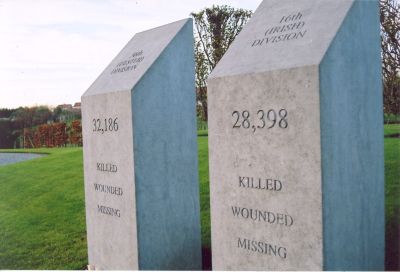Messines and Memory

Collective memorials at Messines to Irishmen from the 36th (Ulster), 16th (Irish) and 10th (Irish) Divisions.
The commanding position of the Irish Peace Park also provides visitors with a stunning south-facing panorama steeped in Great War history. Ninety years on from Messines, the Park muses over the fragility of the soldier’s lot, the short-lived nature of truces and the dangers of unresolved conflicts which may lie buried but which can explode at any time. The 1915 battlefield of Loos and the city of Lille can be glimpsed on the far horizon, with Armentieres nestling in the foreground. Closer in is Ploegsteert Wood (known to the British as ‘Plug Street’) where in 1914 both sides played football in No-Man’s Land during the famous but temporary Christmas Truce. Future war leaders Winston Churchill and Adolf Hitler served in the Ploegsteert-Wytschaete sector. Churchill avoided death by shellfire on his dugout in November 1915 and commanded a battalion of the Royal Scots Fusiliers at Ploegsteert in 1916. Hitler was wounded twice; treated for injuries in the crypt of St Nicholas Church in Messines in November 1914 and gassed by the British at neighbouring Wervicq in October 1918. Both ascribed their survival to Divine Providence. Down the hill, heading south from the Park, lies Petite Douve farm, which still sits atop a huge unexploded British mine, unused from the 1917 Messines operation. Nearby, a second live mine – stable for decades – exploded in 1955 after a lightning strike. There are parallels here too with the violent cross currents of Ireland’s recent past. It is to be hoped that no hidden political mines will detonate as the Irish peace process continues and the north-south truce embodied in the Messines Peace Park will be a durable one. The Battle of Messines is today regarded by Great War historians as a story of British success prior to the horrors of Passchendaele. Messines’ Irish Peace Park adds the message that reconciliation is possible after mutual suffering. Even if the surrounding area bears witness to the uncomfortable truth that undefused ordnance – like political resentments – retain enormous deadly power.
{default}

Hill 60 and Plugstreet also inspired artist Jan Theuninck who made an abstract painting of the trenches at Hill 60 and wrote a poem about it :
http://www.flickr.com/photos/26915283@N07/2536174535/